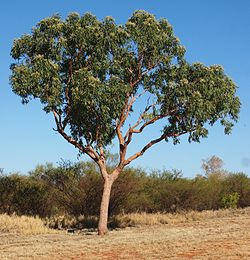Corymbia terminalis
| Desert bloodwood | |
|---|---|
 |
|
| Scientific classification | |
| Kingdom: | Plantae |
| (unranked): | Angiosperms |
| (unranked): | Eudicots |
| (unranked): | Rosids |
| Order: | Myrtales |
| Family: | Myrtaceae |
| Genus: | Corymbia |
| Species: | C. terminalis |
| Binomial name | |
|
Corymbia terminalis (F.Muell.) K.D.Hill & L.A.S.Johnson |
|
| Synonyms | |
|
|
Corymbia terminalis, also known as tjuta, joolta, bloodwood, desert bloodwood, plains bloodwood, northern bloodwood, western bloodwood or the inland bloodwood, is a tree native to Australia.
The tree typically grows to a height of 18 metres (59 ft) and will form lignotubers. It has tessellated light brown to light grey bark that is rough on part or all of trunk, sometimes extending to the larger branches. The leaves are grey-green, glabrous, with a lanceolate blade that is 8 to 20 centimetres (3 to 8 in) in length and 1.2 to 3 cm (0.5 to 1.2 in) wide. Adult leaves are pale green to yellow-green with sparse oil glands. The leaves are alternate, usually concolorous, dull or lightly glossy when mature.
It will bloom between March and October producing inflorescences with terminal panicles and peduncles 0.5 to 2 cm (0.2 to 0.8 in) long and white flowers. Mature buds have an ovoid to pyriform shape and are 0.6 to 1.7 cm (0.2 to 0.7 in) long and 0.5 to 1.3 cm (0.2 to 0.5 in) wide and greenish to brown or cream in color, scurfy and absent of scars. Pedicellate fruit will eventually form that is 1.5 to 3.1 cm (0.6 to 1.2 in) long and 1.2 to 2.2 cm (0.5 to 0.9 in) wide containing light brown or reddish brown seeds that have an ellipsoidal shape and are 9 to 12 mm (0.35 to 0.47 in) long.
The species was initially classified as Eucalyptus terminalis by the botanist Ferdinand von Mueller in 1859 in the Journal of Proceedings of the Linnean Society from samples collected from Arnhem Land in the Northern Territory in 1856.
Botanists Ken Hill and Lawrie Johnson were the first to define the genus Corymbia in 1995, identifying the bloodwoods, ghost gums and spotted gums as a group distinct from Eucalyptus.
C. opaca and C. tumescens, along with several other species, were previously considered to be part of C. terminalis, but were split off in 1995. This split remains controversial, with some authors and herbaria accepting the new species and others considering them to be inseparable from C. terminalis. To the extent that the species can be reliably differentiated, C. terminalis has thinner leaves larger buds and fruit and thicker pedicels than C. opaca.
...
Wikipedia
